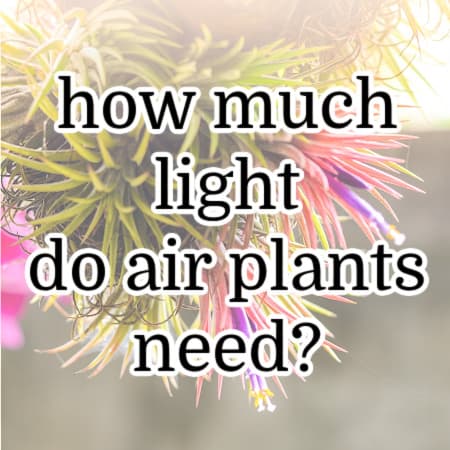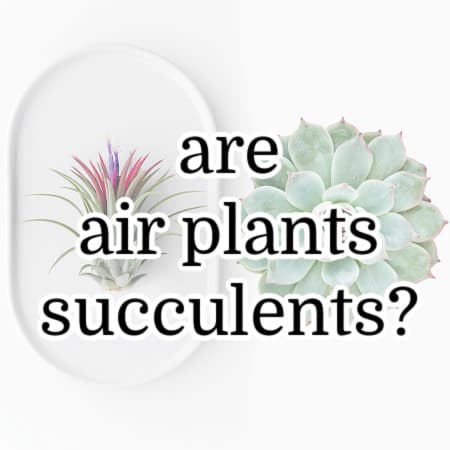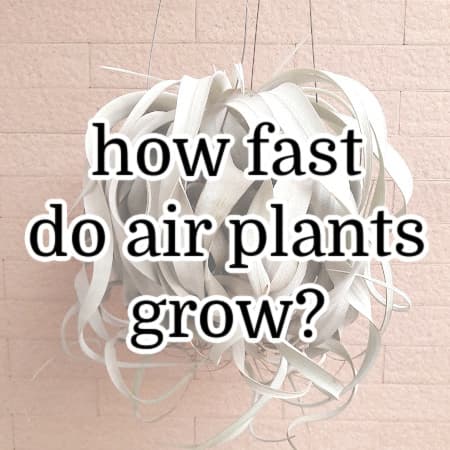How to Water Air Plants (the RIGHT Way!) | Tips and Watering Guide
Do you have an air plant as a houseplant? Are you tired of trying to figure out how to water it and how often? You’re not alone!
Watering air plants can be tricky when you first start out, but I’ve got you covered. In this blog post, we’ll discuss how to water air plants correctly for optimal growth, how much water they require, and a few other important air plant care facts.
We’ll also discuss other important things like which types of air plants need more or less water than others and what type of water is best.
OK, let’s get started!
Pin this to your favorite gardening board on Pinterest!
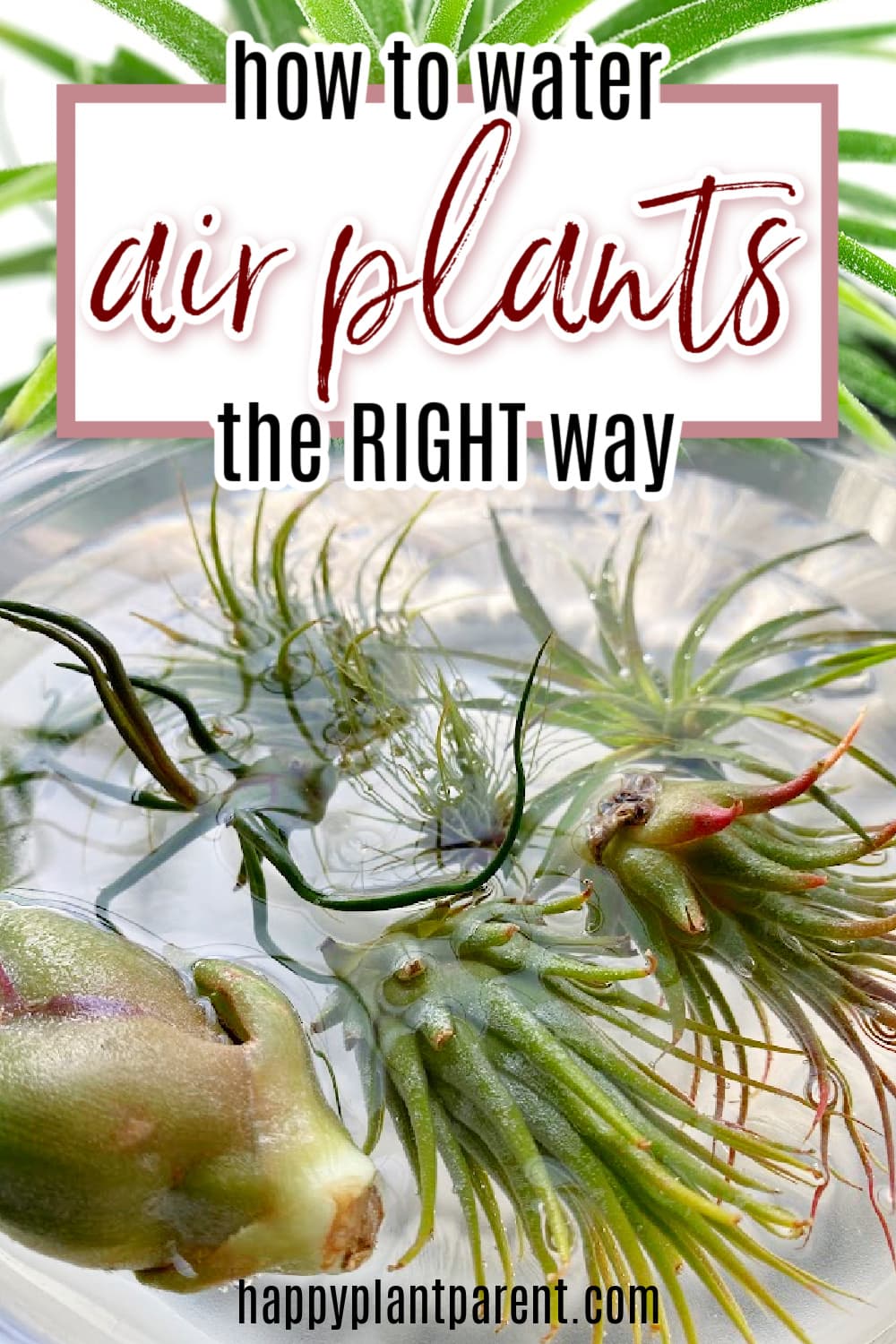
(This post contains affiliate links. If you click one and make a purchase, I may receive a commission at no extra cost to you. Read the disclaimer here. Thank you for your support!)
What is an Air Plant?
Air plants are tropical plants that have adapted to growing in arid climates with no soil. They’re also known as Tillandsia and they belong to the Bromeliaceae family of flowering plants.
These unique little plants are native to regions of Central and South America, as well as some of the southern states in the US such as Florida and southern California.
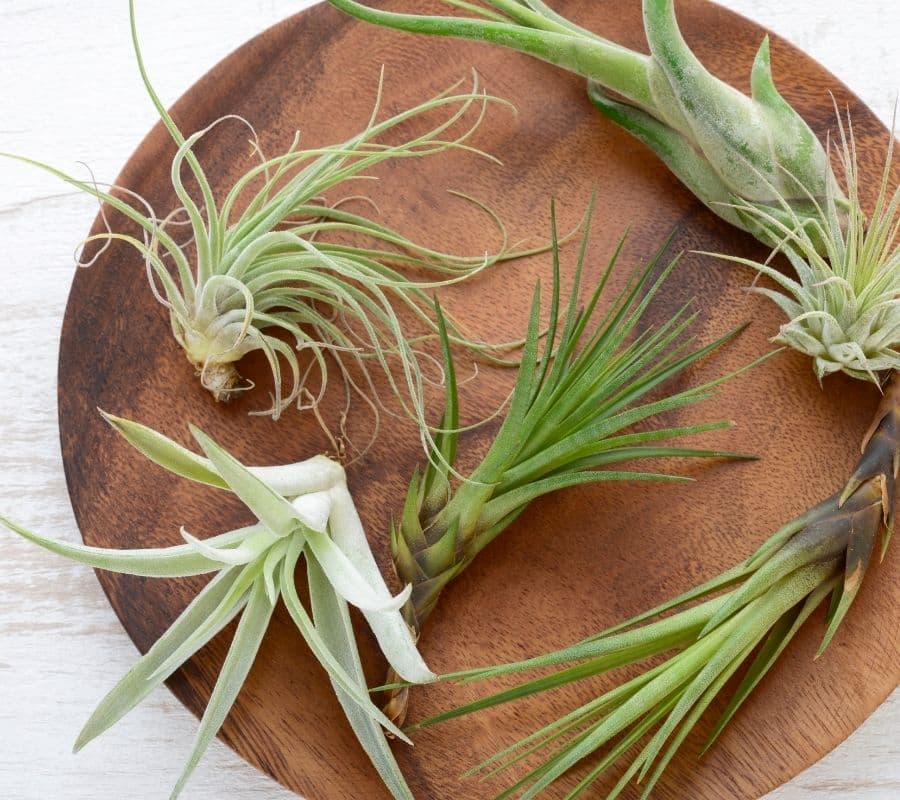
One of the amazing things about air plants (and why they got their name) is that in their natural habitat they grow without any soil and instead attach themselves to other plants using their root systems. They aren’t parasitic, they’re just there for the ride.
Instead of absorbing nutrients and water through their roots like most other plants, they absorb everything through their leaves thanks to scale-like structures called trichomes.
That means you can water air plants the way you water most of your other houseplants. You may be pretty surprised when you find out how to properly water air plants, I know I was!
The Right Way to Water Your Air Plants
The best way to water air plants is to give them a good soak in cool, filtered water between 20 minutes and 4 hours once a week. Then shake them off to remove excess water and let them dry out a bit before you return them to their display.
Yes, that’s right. You might feel like you’re drowning your poor little air plants, but they actually love getting a water bath.
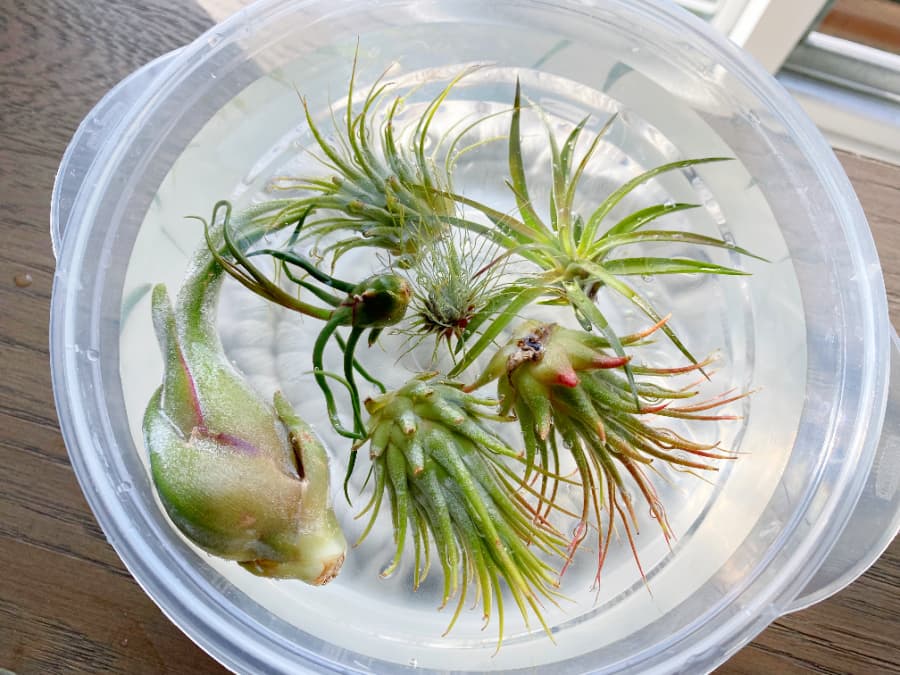
It took me a little bit to get used to this routine, but the results have spoken for themselves.
Now, this method works really well for most varieties of air plants, but there are some that it’s not ideal for.
One air plant that needs to be watered a bit different is the Tillandsia Xerographica.
To help it keep it’s beautiful characteristic curly leaves, it’s better to give it a quick dunk, making sure it’s fully soaked. Then shake it out and let it get some good air circulation before putting it back in its home. You’ll need to do that every few days to keep it hydrated.
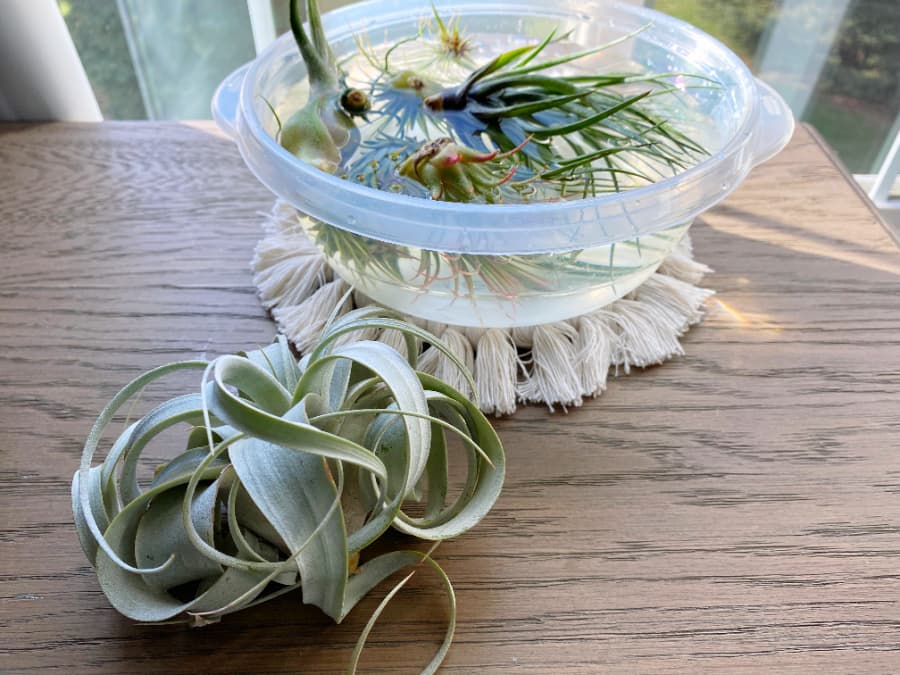
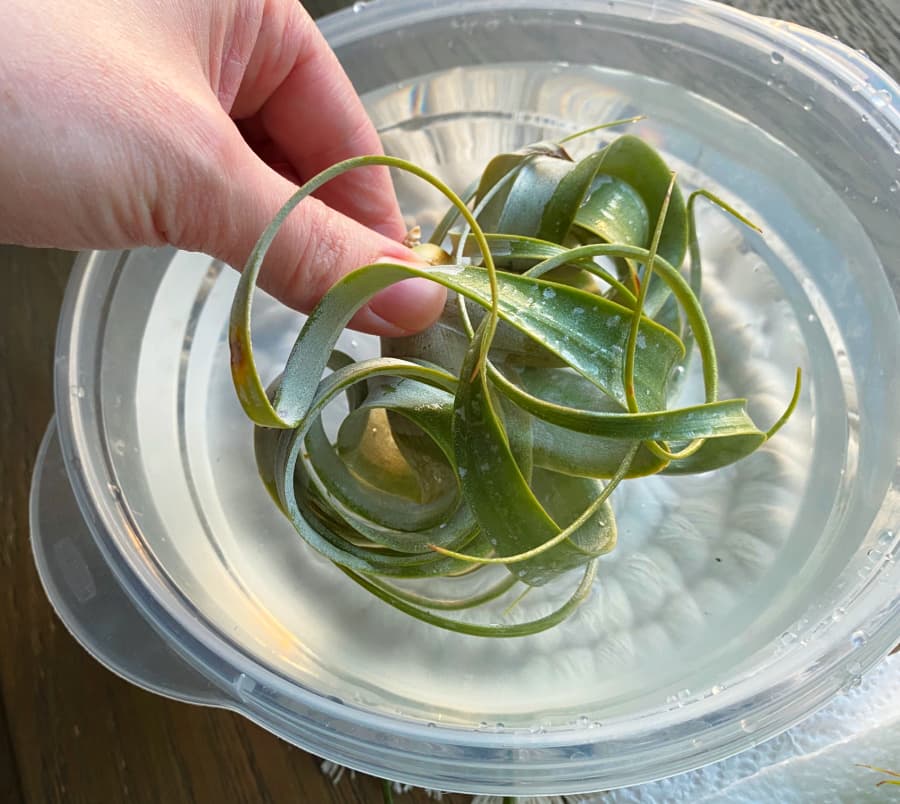
Another air plant that doesn’t do well with the soaking method is T. Tectorum. This air plant with it’s characteristic super fuzzy trichomes does best with a thorough spritzing every 1 to 3 weeks.
Be sure to read up on the type of air plant you have before you begin a watering schedule.
If you’ll be putting your air plants into glass terrariums or glass globes, it’s crucial that you don’t leave any excess water inside your plants or they can develop rot.
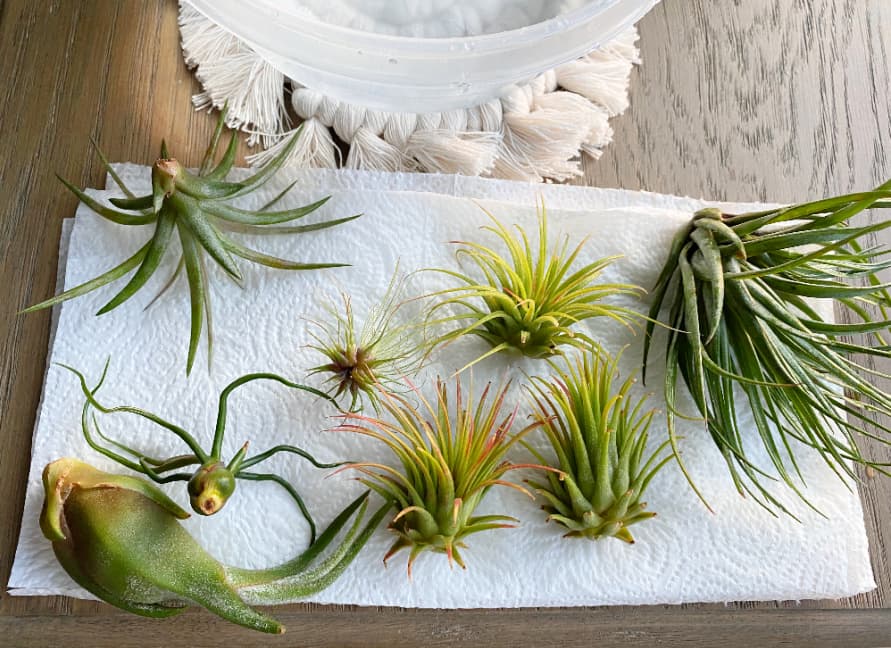
Let’s get into some more specifics about watering your air plants with this method as well as the misting method.
What Kind of Water to Use
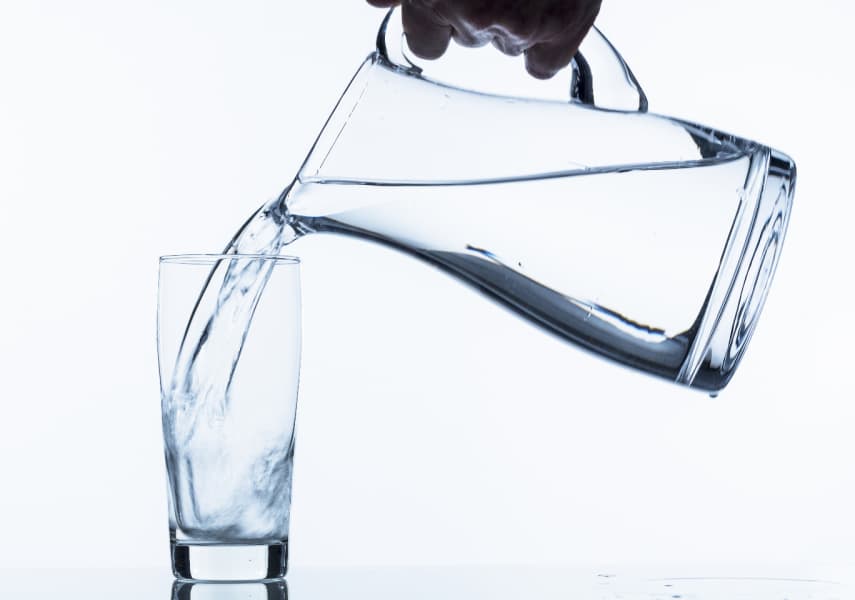
Air plants are sensitive to excess chlorine and fluoride that’s present in tap water in the US. It can cause the leaves to get brown on the tips, and sometimes it’ll just flat out kill your little planties.
You can get distilled water for watering your air plants, or you can use filtered water if you have a filter that removes chlorine and fluoride.
We have a countertop water filter that gets rid of all of that (it’s great for people and plants!) Our family has been using it for 3 years and it works great.
If you don’t have access to a filter but don’t want to buy special water for your plant, another way to minimize the problem is to run some tap water into a bowl and let it sit for 2 or 3 hours before you water your plants with it.
This will let some of the chemicals off-gas and evaporate so it’ll at least lessen the blow.
You can also use pond water if you have it to water and fertilize your air plants all at once. Be sure it’s a pond that grows green algae on it and that it isn’t polluted water.
Another excellent option for watering your air plants is rain water.
Watering Needs Throughout the Seasons
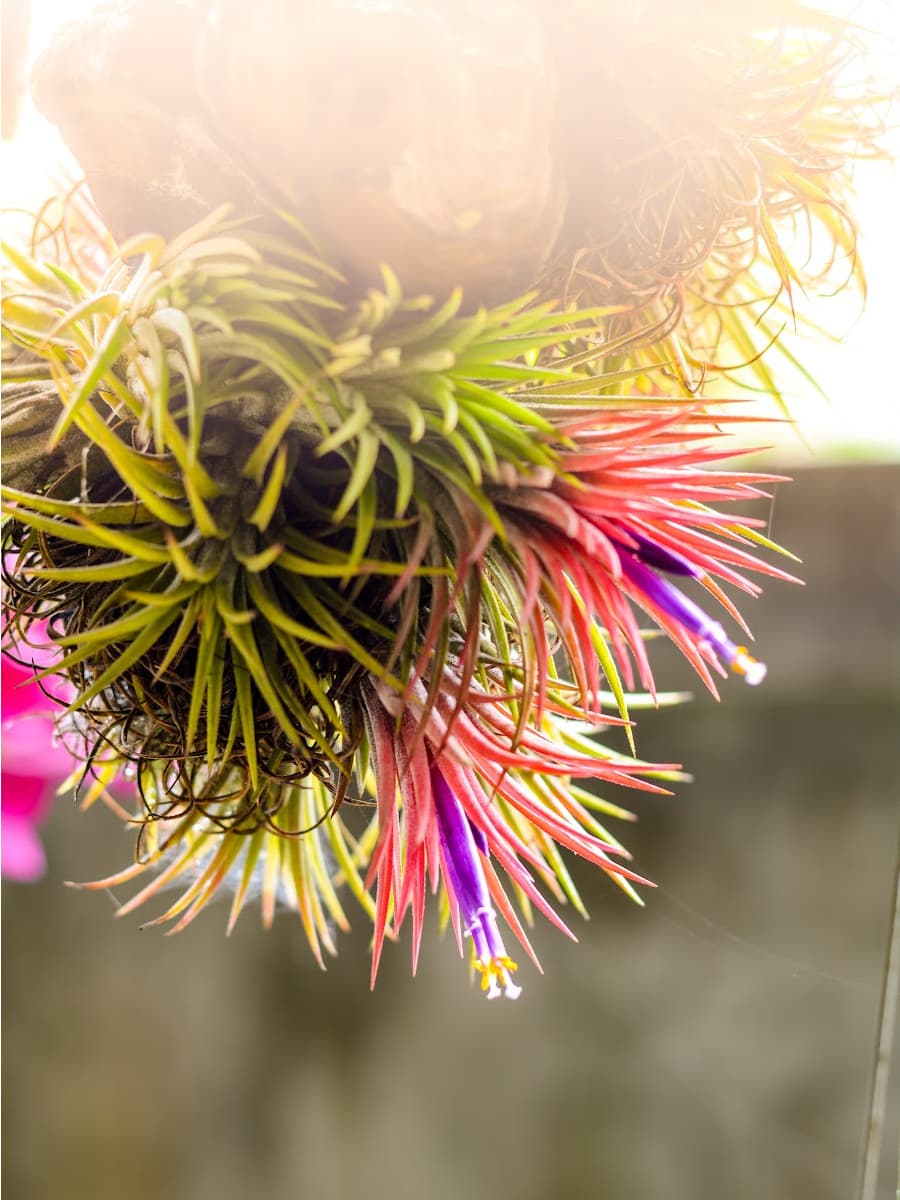
If you have air conditioning in your home, your indoor plants won’t be affected too much by the changing of the seasons or the time of year.
That being said, having the heat on in the winter definitely dries out the air and you might notice your plants being thirstier than usual.
Likewise, if it gets very hot in your home during the summer, they may need a bit more water as well. However if you have super humid conditions in the summer, they may require less watering.
It’s best to get to know your plants and what their signs of thirst are. Then you can just water them a bit more with no worries.
Signs of thirst in air plants include:
- leaves curling or folding in
- they’re noticeably lighter
- brown leaf tips
To Mist or Not to Mist
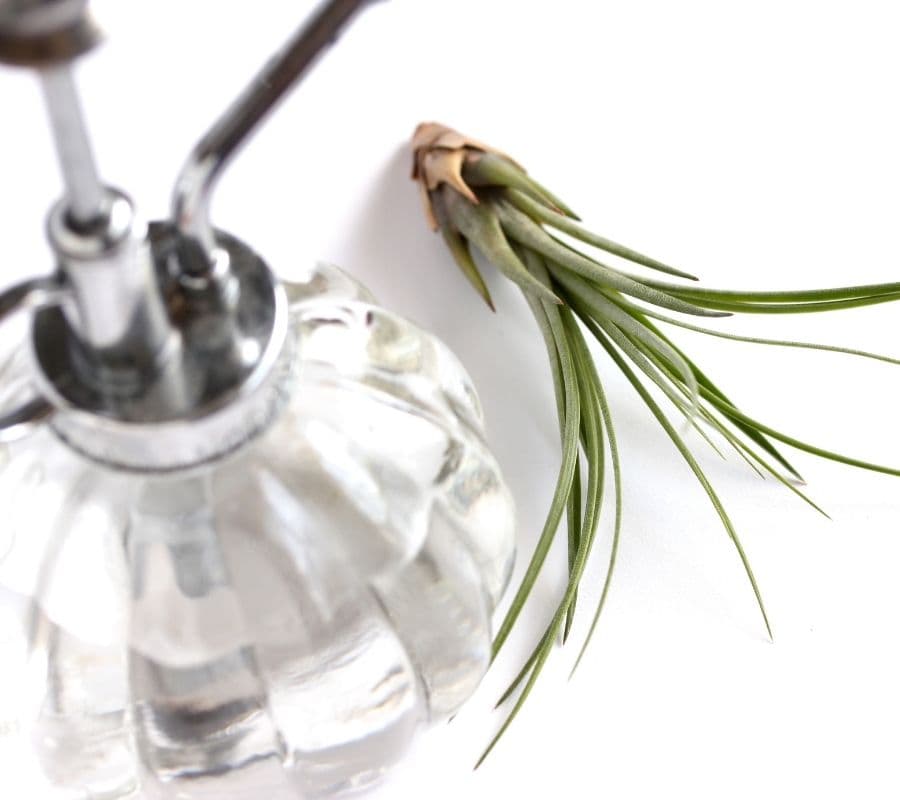
A lot of times you’ll see people say to mist your air plants frequently to water them.
If you’re doing the weekly soak method, this is probably unnecessary for a lot of air plants. A few of the water loving ones might appreciate a spritz in between waterings, especially if they’re getting extra light or if the air is particularly dry.
You can water your air plants exclusively through misting, but you’ll have to spray them with a misting bottle frequently and thoroughly to get them enough water this way. I’ve personally had much more luck with a weekly soaking than with frequent misting.
Like I said earlier, a few types of air plant (mainly super fuzzy, Xeric varieties) thrive on thorough misting instead of a soak.
Air Plant Watering Problems and Troubleshooting
Now that you know how to water air plants the right way, let’s go over some of the most common problems people experience with their air plants.
Brown Leaf Tips
Brown leaf tips can be caused by under watering, too much sun, or from too much chlorine or fluoride in your tap water.
If you haven’t been watering your air plants very often, start doing the soak method for about 2 hours once a week.
If the brown tips are from chemicals in your water, switch to distilled or filtered water for watering.
Make sure your air plants aren’t getting too much direct sunlight, it’ll burn their poor little leaves. Some types of air plants can handle more bright light than others (see my article on Xeric Air Plants vs. Mesic Air Plants), but generally they all prefer indirect light.
Rot
Rot can be caused by over watering your air plants, or believe it or not from under watering. It can also be caused by not giving your plants enough indirect sunlight or from keeping your plant in a humid place without enough air flow.
You’ll know its rot if you see dark, mushy areas on the base of your air plant’s leaves. It can come on suddenly, and it’s typically too late when you see it.
It’s important to shake any excess water out of your air plants after watering, and be sure they’ve had a chance to dry out a bit before you return them to a terrarium or any other partially enclosed environment.
I lay mine upside down on paper towels to drain for a good hour after watering.
Pests
Pests are every house plant lovers worst nightmare, especially if you don’t like bugs!
Luckily, air plants are rarely affected by pests, but sometimes you’ll get some mealybugs or scale.
Mealybugs leave a white, cotton like substance on your plants leaves, and scale looks like little scaly bumps on the stems and leaves of the plant.
The best and safest way to get rid of these little guys is with isopropyl alcohol.
First, do a regular soak in filtered water for at least an hour. This will get rid of a lot of the pests already. Then, you can put 90% isopropyl alcohol in a spray bottle and spray it all over your plants and let them dry.
Be sure to keep the infested plants away from all the others until you know you’ve gotten rid of the pests. You don’t want them to spread!
Best Places to Get Air Plants
I’ve purchased air plants from a variety of sources, and I’ve had the greatest success with healthy ones when I buy online.
As much as I love rescuing plants from my local hardware store, they tend to come with stowaways in the form of pets and diseases that I don’t want to spread to my healthy plant babies!
Here are a few of the places I buy my plants from and absolutely love doing business with:
In Conclusion
Now that you know how to water air plants, how they’re different from other houseplants and how often to water them – hopefully your plant babies can flourish!
What’s your favorite way to water your air plants? Got any additional tips? Let us know down below in the comments!

